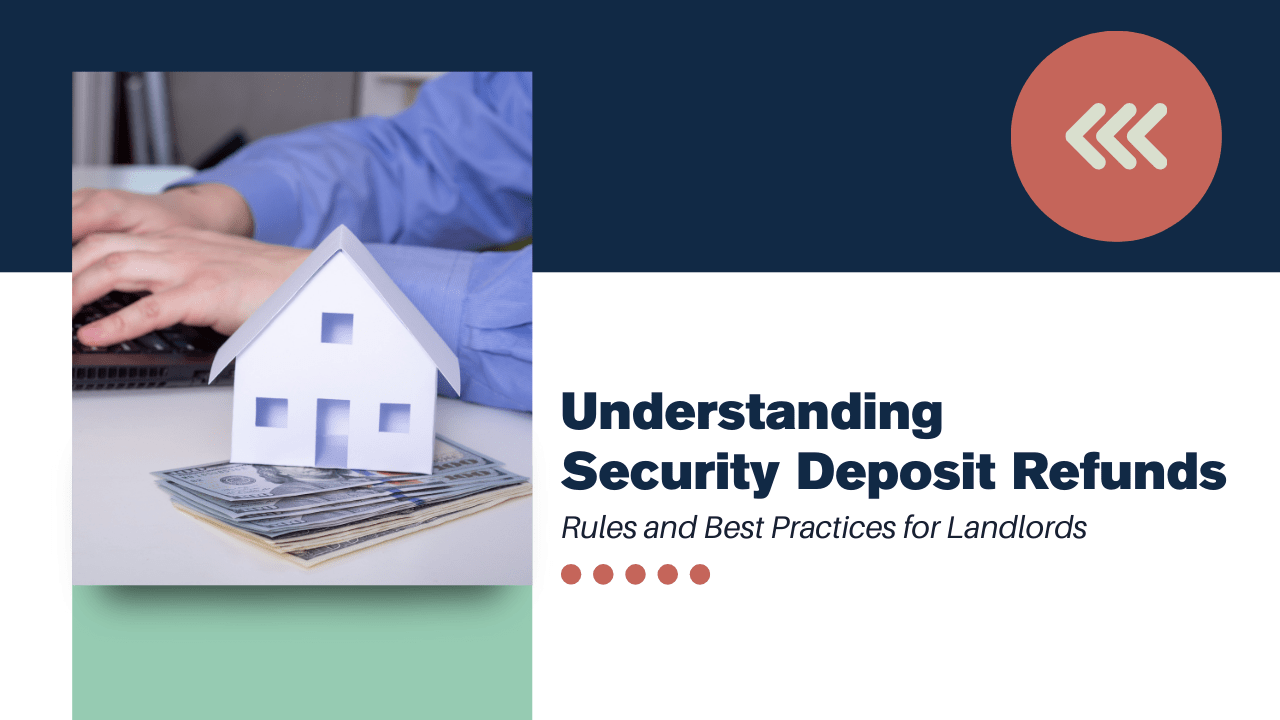As you know, security deposit laws changed in California in 2024. As of July 1, 2024, there’s a new limit to what most landlords and rental property owners can collect. That limit is the equivalent of one month’s rent. There are exceptions, but very few property owners we know are charging more than that one-month equivalency.
Today, however, we aren’t talking about how to collect a security deposit. Instead, we’re taking a closer look at how to return or refund a security deposit in Southern California.
Why?
Because this is where things are most likely to go wrong.
We have helped a lot of rental property owners avoid security deposit disputes and conflicts, and here are the rules and the best practices that you’ll want to understand in order to end a tenancy with a good relationship and a solid reputation intact.
Security Deposit Timing: California Deadlines
California law mandates that landlords must return a tenant's security deposit within 21 days after the tenant moves out. During this period, landlords must either:
- Refund the entire security deposit, or
- Provide a detailed written itemization of any deductions, along with the remaining deposit balance.
We’ll talk next about what those allowable deductions include and exclude, but for the purposes of timing, it’s important to understand that you have those 21 days. Failing to meet this 21-day deadline opens the door to consequences that can escalate quickly.
What Happens If You Return a Security Deposit Late?
Returning a security deposit late can lead to significant legal and financial risks for
California landlords:
Beyond the legal penalties, returning a security deposit late can harm your reputation as a landlord, affecting your ability to attract and retain tenants in the future.
What Are the Reasons You Can Keep or Deduct from the Security Deposit?
- Unpaid rent or utilities
- Cleaning costs (to return the unit to its move-in condition, excluding normal wear and tear)
- Repairing damage caused by the tenant beyond ordinary wear and tear
- Replacing missing items, such as furniture or appliances
Let’s get a little more detail around these reasons:
What’s Wear and Tear? What’s Damage?
A lot of owners struggle with understanding the difference between wear and tear and damage. We have given a few examples above, but we know it can be complicated to make a quick decision during the course of a move-out inspection.
At the very basic definition, normal wear and tear occurs when items age or deteriorate. This will happen to paint and carpet in a home no matter who is living there. Landlords in California are responsible for general wear and tear items; you’ll have to pay to get the property ready for a new tenant, and that will usually include things like painting and carpet cleaning. You cannot charge a tenant’s security deposit for those tiny holes in the walls from where pictures are hung. You cannot charge for scuff marks on the floors and the walls from furniture.
Damage, by definition, is anything that’s a result of negligence, abuse, or carelessness. Something like a broken dishwasher door could be accidental, but it’s still damaged. These are things that tenants are required to pay for, and the cost is deducted from the security deposit at the end of the lease term.
Lifespans and Lifecycles
This chart may help. It shows a general estimate of how long you can expect things to last and what they look like when they’re damaged or simply the outcome of normal deterioration.
A move-in inspection and checklist are critical in order to compare the condition of the property to its move-out condition. When you work with a
local property management company, you can expect that a thorough survey will be conducted to effectively protect your property and distinguish between wear and tear and damage at the end of the tenancy.
All Security Deposits are Refundable in California
Maybe you think it’s just easier to disclose upfront that you won’t be returning the security deposit; and that it’s non-refundable.
That’s illegal in California. You cannot have a nonrefundable deposit.
To recognize the difference, let’s talk about pets. If you’re going to allow a tenant to move into your property with a dog, you can charge a pet fee or a pet deposit. The deposit is going to be refundable at the end of the tenancy. If there is no pet damage, the tenant gets the pet fee back. It’s a great way to incentivize good behavior and careful property protection. If you collect a pet fee instead, that’s non-refundable. The tenant is going to never see that money again. It’s great for you because it means you get to keep the entire sum, regardless of whether there’s pet damage or not. But there’s really no incentive for that tenant to avoid pet damage. They’re not getting that money back anyway.
A Word about Utility Bills
You can withhold money from the deposit to cover any unpaid rent and utility bills that the tenant did not pay before moving out. This can be tricky, depending on how you have your utility accounts and payments structured for a rental. The final bill may not arrive until after the tenant has left. If they have not settled up with the utility company or with you, it’s important to determine what you’ll withhold from the deposit to cover those unpaid charges.
Hot Tip: Avoid Over-Charging Your Tenant’s Deposit
While landlords may charge the price of the materials used to repair tenant caused damage, they may not charge exorbitant fees for their personal time involved in the process of making these repairs.
Let’s Look at Best Practices for Returning Security Deposits in California
To avoid conflicts and ensure compliance with Security deposit laws, implement the following best practices:
- Have a Clear Move-In/Move-Out Checklist. Document the property's condition with photos and signed agreements from the tenant at the start and end of the lease.
- Communicate Expectations. Clearly outline in the lease agreement what the tenant is responsible for regarding cleaning, repairs, and returning the property in its original condition.
- Be Transparent. Provide a clear itemized statement with all receipts and documentation for any deductions.
- Stay Updated. California housing laws can change, so keep up with the latest state and local regulations to ensure compliance.
California law requires landlords to offer their tenants a pre-move out inspection.
This is important.
A pre-move out inspection is a walkthrough of the rental property conducted before the tenant officially moves out.
California law says that landlords are required to offer tenants the option of this inspection no earlier than two weeks before their move-out date. The purpose is to identify potential damages, provide the tenant with an opportunity to address them and facilitate a smoother transition for both parties.
This is an excellent way to avoid security deposit disputes and mistakes.
During the inspection, landlords can document any issues, compare the current state of the property to the condition noted at move-in, and give tenants a written itemized list of potential deductions from their security deposit.
Good Reasons to Offer a Pre-Move Out Inspection
Added Benefit: Streamlined Turnover Processes
A streamlined turnover process means your property is ready for the next tenant sooner. Addressing issues during the pre-move out inspection puts you ahead of the game by identifying what repairs or deep cleaning tasks require attention before re-listing the property.
The faster you can prepare your property, the faster you can secure new tenants, saving you time and money.
How to Conduct a Pre-Move Out Inspection
Not sure how to get started with this inspection, nor how to conduct it?
This is one great reason to
work with a local property manager who can help you navigate not only the inspection but the entire security deposit return. Here’s how we go about offering tenants their pre-move out inspection:
1. Offer the Inspection in Writing
We start by notifying the tenant of their right to a pre-move out inspection at least two weeks before their move-out date. This notice can be provided via email, certified mail, or hand-delivered. We know tenants are not required to accept this offer, but we’re always encouraging because of the benefits it provides to all of us.
2. Schedule a Convenient Time
We work with the tenant to find a mutually agreed-upon time for the inspection. Keep in mind this walkthrough is a collaborative effort, so being flexible can go a long way in maintaining a positive relationship.
3. Inspect Thoroughly
We bring along the original move-in condition checklist to compare the current state of the property. Our team pays attention to key areas such as walls, flooring, appliances, and fixtures. We are sure to document any damages with photos or notes.
4. Provide a Written Report
After the inspection, we provide the tenant with a detailed written list of any necessary repairs or cleaning. We are clear about which issues may result in deductions from their security deposit if not resolved.
5. Follow Up
We’ll give the tenant a chance to address the issues identified during the inspection. This could include cleaning, repainting walls, or repairing minor damages.
6. Conduct the Final Walkthrough
Once the tenant moves out, we perform the final walkthrough with the written report in hand to verify that the issues have been resolved or determine final deductions.
Our tips for a successful pre-move out inspection are pretty simple:
- Be Transparent. Show the tenant exactly what you’re documenting. Transparency builds trust and reduces misunderstandings.
- Document Everything. Take photos and include them with the written report. This creates a clear record for both you and the tenant.
- Focus on Communication. Approach the process professionally and respectfully. Explain the purpose of the inspection and answer any questions they may have.
Offering a pre-move out inspection policy isn’t just about compliance—it’s an opportunity to protect your property, maintain positive tenant relationships, and streamline your turnover process. Fewer disputes mean less stress for you and greater satisfaction for your tenants.
We can talk with you more about the importance of following the law in every part of the move-out process, particularly the security deposit return. If you’re worried about getting the deposit returned within 21 days, struggling over the distinction between wear and tear or damage, and unsure about inspections, we can help.
Contact us at Niguel Point Properties.








